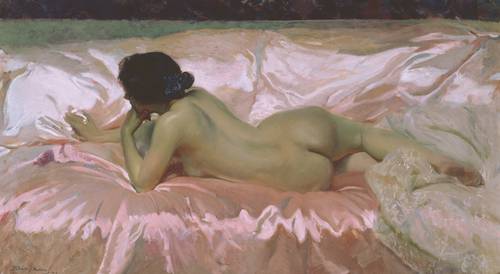Madrid. As a climax to the commemorations by the centenary of Joaquín Sorolla, the gallery of the royal collections inaugurated a retrospective expans Trafficking in persons, the hardness of work in the field or fishing and hunger for households, even their acquaintances and admired portraits, their Costumbristas scenes and, of course, his great paintings on the sea, especially that of his land, the Mediterranean.
The exhibition Sorolla: one hundred years of modernity He has popularized as never the artist’s work, since only three and a half months after his opening have already visited 80 thousand people, so it was decided to expand it until April 20.
The exhibition, organized by Spanish National Heritage, Light Art Exhibitions, in collaboration with the Sorolla Museum and the Sorolla Museum Foundation, gathers 77 significant works of all its stages and the main topics that its production covers. This gives an integral vision of the evolution of one of the most admired and beloved artists, who forged his career as an artist at the docks of his region, Valencia, contemplating the festival of colors of heaven and the sea, but also with a deep Academic preparation, especially in Madrid, Paris and several cities in Italy.
Among the paintings that have been displayed very little to the public stand out Boulevard of Paris (1889) y La Giralda, Seville (1908), two works that were not exposed since the death of the painter. The works can also be seen for the first time in Spain: Portrait of the Mexican Tiple Esperanza Iris (1920), Arc and Puerta de Santa María, Burgos (1910), Children bathing o Afternoon sun, Valencia (1909) y Boats in Jávea (1905). The pieces come from the institutions that treasure the best collections on the painter: the Sorolla Museum and the Sorolla Museum Foundation, the Hispanic Society of America, the Prado Museum or the Museum of Fine Arts of Asturias; of great museums such as the Musée d’Orsay and other enclosures and public and private collections, both from Spain and the United States and Mexico.
The exhibition makes a chronological tour of the painter’s own evolution, hence he begins with some of the paintings that made him still very young in a unique artist, including some of his most emblematic works, such as They still say that fish is expensive! o The return of the fishing (1894). In the second section one of its great songs, the sea, for which some of its most beautiful and iconic works were deepened, such as The pink robe, Walk to the sea shore o Boys on the beach.
Among the 20 portraits chosen for this sample include a 1909 sorolla self -portrait, portraits of illustrious characters and families such as Lady of Ira Nelson Morris and her children; the portrait made to photographer Antonio García in his laboratory; The Benlliure Arana family; Santiago Ramón y Cajal, Juan Ramón Jiménez or José Echegaray, among others.
The exhibition also addresses the way in which the popular reality of Spain expressed, for which he toured the country after a commission of the Hispanic Society of America, in a set of works known as Vision of Spain.
Finally, Sorolla’s facet in the last years of his life, in which he focused on painting landscapes, is present with works by the Alham-Bold of Granada, the Alcazar of Seville, the Cathedral of Burgos or a flow of the Nalón River , in Asturias.
